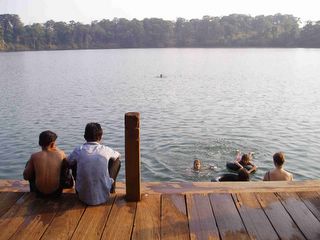Ratanakiri - Day 1
Dusty and exhausted from our night on the road, Kamil, Aska, and I soon found our way through an ad in front of a motorbike rental shop to a small $2/night guesthouse. The guesthouse was actually the bikeshop owner’s home, a wooden building across the street from a small lake. There were two restaurants by the lakeside, the larger one staffed by several waiters, and the smaller one owned by a family of Cham Muslims.
Aska and I left an exhausted Kamil behind, hiring a moto to investigate one of Ratanakiri’s biggest attractions, Yeak Lom, a big round crater lake, about three hundred metres wide and about fourty metres deep, surrounded by forest. The water was clear, refreshing, and cool, cold but not too cold. Beer and mango stalls awaited us by the small dock at the side of the lake. Happily, the mangos were their usual reliably tasty selves as was the beer. For some inexplicable reason, not only d the Khmer love beer but they do heck of a good job brewing it too.
We spent so long at the lake that by the time we were ready to depart, the sun was nearly setting and the last moto-taxi had left. Aska and I began the 5km walk back to the guesthouse in the dark, hoping we wouldn’t make a wrong turn. About two-thirds of the way there, a taxi pulled up beside us, asking in clear English, “Do you need a moto to go to Ban Lung?” We haggled a little and were soon on our weary way. “I’m not actually a moto driver,” our unexpected rescuer told us, “but you looked very lost. I work for an NGO, Care. I help with training and education for some of the tribespeople. I’m also working on the final touches for an illustrated Khmer-Tampuon-Kreung dictionary. My name is Samoeun. Do you need a guide? I have no work right now because of Khmer New Year and would be happy to show you through Ratanakiri.”
Ratanakiri is home to the bulk of Cambodia’s hill tribe minorities, several different groups known collectively sometimes as Chunchiet, sometimes as Khmer Loeu. The Khmer Loeu have a long history living near to the Khmer but have maintained what we would consider a more aboriginal mode of existence, complete with their own languages and religious beliefs. Samoeun we soon discovered was from a local tribe of the Tampuon group. I took down his phone number, promising that if we needed a guide, we would contact him.
By the time we returned, Kamil had given up waiting for us at the guesthouse. Politely turning down an offer to join our host for dinner, we went in search of him. When we found him, he was finishing a meal at the Cham Muslim restaurant. We sat down to join him, discovering as we did so that one of the family members, recently returned from work in Phnom Penh so as to be with family during her pregnancy, was nearly fluent in English. I took advantage of the opportunity to ask her some questions about her people, their history, and how their Muslim beliefs were affected by the dominant Buddhist culture. She was happy to answer the questions and left me with an open invitation to have her son or one of her other relatives accompany me on a visit to their mosque.
One day in Ratanakiri and I found myself living in a Buddhist home for Khmer New Year, being offered tours by a guide from the hill tribes, and receiving an open invitation to visit a Cham Muslim mosque. The Religious Studies major in me was very pleased.


0 Comments:
Post a Comment
<< Home